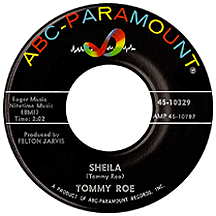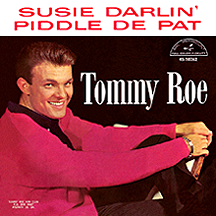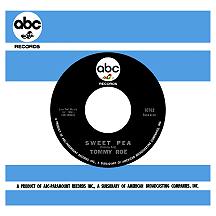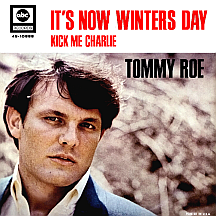TOMMY ROE
When Tommy Roe was growing up in Atlanta, so were future music stars Ray Stevens, Joe South and Billy Joe Royal. The four would cross paths often during the 1960s on the way to building successful careers. For Tommy, born in 1942, it was during his high school years in the mid-'50s that he formed a group with two of his pals from Brown High School, calling themselves The Satins (after a favorite of theirs, The Five Satins, who had hit big in 1956 with "In the Still of the Nite"). By 1960 he was already making music professionally, having recorded "I Got a Girl" with the Satins for the Mark IV label. He met Felton Jarvis, who'd waxed a couple of his own records including "Don't Knock Elvis," a spoken rockabilly record that would presage his work producing Presley's music from 1966 through 1977. Jarvis had gotten the bug to produce records, the result being a song Tommy had written when he was 12 about a girl he had crush on named Freida.
Tommy hooked up with NRC Records, where his friend Joe South had seen minor success with the novelty tune "The Purple People Eater Meets the Witch Doctor" (attempting to capitalize on not one, but two chart-topping 1958 hits). It was on NRC's subsidiary label Judd that he and the Satins released his ode to that neighborhood girl, although he changed her name in the song to "Sheila." The record, with a solid southern beat, went largely unnoticed on its first release in 1960. Clark and West drifted away over the next year or so and Tommy took an industrial job as a solderer for General Electric, later landing a contract with ABC-Paramount and rerecording "Sheila" with an arrangement similar to Buddy Holly's "Peggy Sue." A lineup of then- and soon-to-be-stars backed him on the studio session, including another of his old Atlanta cohorts, Ray Stevens. When the 45 was released, he was understandably skeptical of its chances and insisted on keeping his day job rather than go on the road to promote the record, but when ABC offered him an advance of five thousand dollars, he bid GE bye-bye. To his amazement, "Sheila" outperformed Holly's rock and roll standard, hitting number one in September 1962. The song also went top ten in England, where Tommy would soon be spending some quality time.
The follow-up, a remake of Robin Luke's 1958 hit "Susie Darlin'," hit the top 40 and in March 1963 he and Chris Montez (fresh off his own top ten smash "Let's Dance") embarked on a tour of England, co-headlining a 21-city show that had The Beatles (at the time enjoying their first top ten U.K. hit, "Please Please Me") as its opening act. Yet as the tour progressed, the Beatles brought more and more attention on themselves, suggesting that they were on the verge of much greater success. At a show in Liverpool on March 24 where Chris and Tommy allowed them to close the show (it was the group's hometown, after all), fans were in the early throes of Beatlemania and our American boys got lost in the convulsion. Yet it all worked in Tommy's favor, as "The Folk Singer" reached the top ten in Britain just after the tour ended (though the song barely hit the radar in America).
While cruising back to the U.S. on the Queen Elizabeth, and not particularly phased by the upstaging the Beatles had inadvertently carried out, Roe wrote "Everybody," and in a contrasting change-of-scene recorded the song at the FAME studios in Muscle Shoals, Alabama, where many of the hottest R&B acts of the decade did their best work. It turned out to be his most uptempo rocker yet and in November 1963 became Tommy's second top ten hit. "Come On," a soundalike, suffered in comparison, and "Carol" was a little too close to the arrangement of Chuck Berry's original to gain much notice in the spring of 1964; the '50s retro gimmick had played itself out for Roe, particulary considering that by this time his former tourmates The Beatles had brought the British Invasion across the ocean to supply fresh and unwielding competition to U.S. artists.
Having fallen into a slump in '64 and '65 but still under contract to ABC-Paramount, Tommy joined the Army Reserves, doing six months' active duty followed by a move to New York City to take a stab at an acting career. Upon discovering that his name in the music industry didn't automatically open doors in film and/or Broadway, he headed back to Los Angeles. He had continued to write songs while in the Big Apple, notably "It's Now Winters Day," which came to him while spending the coldest season in the city, and "Sweet Pea," a whimsical love song reflecting a more pop-based direction than he'd taken thus far. A session at Gary Paxton's home studio resulted in the latter becoming a top ten hit in the summer of 1966 with its follow-up, "Hooray For Hazel," repeating the feat in the fall, establishing him anew as a teen heartthrob.
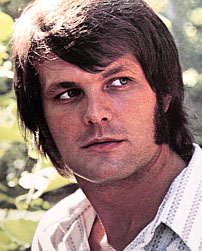
Still, he was finding out that the business of making hit records was feast-or-famine, a pattern that was certainly preferable to one-and-done. After "It's Now Winters Day" went top 40, he enjoyed the next two years on the concert trail with a solid backlog of hits to perform, yet his action on the charts was limited to a couple of barely-noticed showings under the heading "nice try." The biggest year of his career was yet to come. Co-written with Freddy Weller of Paul Revere and the Raiders, "Dizzy" took him to the moon in 1969, a multimillion-selling number one hit in both the U.S. and England. This undeniable airplay monster leaned dangerously close to the bubblegum movement that was at its peak in the late '60s and that connection probably had a lot to do with the song's ascendance to the top. He didn't stop there; "Heather Honey" hit next and at the end of '69 he surrendered completely to the lucrative lure of bubblegum music with "Jam Up and Jelly Tight" (also written with Weller), another top ten smash. Throughout his career, Tommy Roe had written most of his own music as he adapted to trends, gradually straying from his southern rock and roll roots, but clearly possessing the goods to deliver hit records.
In 1971 he had one final top 40 hit with the traditional folk song "Stagger Lee" (made famous by Lloyd Price in 1959), followed by a mildly successful move to country music in the '70s and '80s. Tommy's marriage to French actress Josette Banzet, who won a Golden Globe Award for Best Supporting Actress for her performance in the 1976 TV miniseries Rich Man, Poor Man, has stood the test of time.
NOTABLE SINGLES:
- I Got a Girl - 1960
with the Satins - Sheila - 1960
with the Satins - Sheila - 1962
- Susie Darlin' - 1962
- The Folk Singer - 1963
- Everybody - 1963
- Come On - 1964
- Carol - 1964
- Party Girl - 1964
- Sweet Pea - 1966
- Hooray For Hazel - 1966
- It's Now Winters Day - 1967
- Sing Along With Me - 1967
- Little Miss Sunshine - 1967
- Dizzy - 1969
- Heather Honey - 1969
- Jack and Jill - 1969
- Jam Up and Jelly Tight - 1969
- Stagger Lee - 1971


